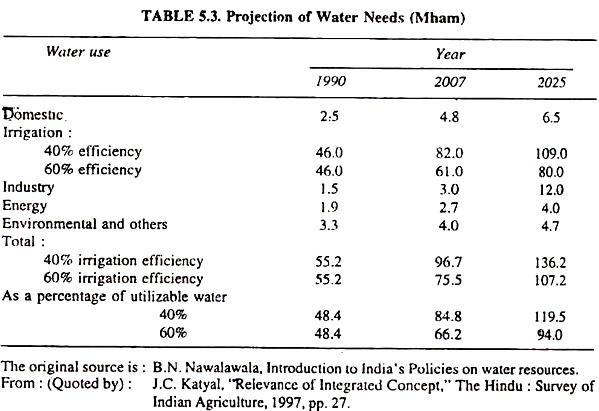After reading this article you will learn about the importance of water in agriculture.
Water is life. Its availability in sufficient quantity and acceptable quality for agriculture determines the sustainable performance of diverse crops. Rain being the primary source of water, India receives 400 million hectares meters of water which is less than 1 per cent of global precipitation.
There is no uniform distribution of water it has wide variation. Out of the total water from the rains only 187 million hectares is potentially available. Currently water use efficiency by arable crops is around 40 per cent. But technologies are available to raise it to 60 per cent.
65 per cent of agriculture in India is rain-fed which contributes 44 per cent food and supports 40 per cent of human population. Losses of rainfall through leaching, runoff etc. should be checked. Rainfall harvesting offers tremendous scope for augmenting water availability.
The net irrigated area is 50 million hectares distributed by canal, tanks, wells and others. There is a great between potential and utilized varying between 8.65 and 22 Mha. Waterlogged area is 8.5 Mha salinity affected area is 9 Mha. There is poor water use efficiency causing these maladies.
There is a rich diversity of plant species—15,000 to 18,000 flowering species (angiosperms), 3,000 species are economic plants, 1,000 food supplying species, 1,500 medicinal uses, 8,000 species of ethno-botanical interest, 160 represent cultivated plants.
There is also animal diversity. There is a highly significant diversity among domesticated animals. There are 26 breeds of cattle, 8 buffaloes, 40 sheep’s, 26 goats, 8 camels, 14 horse and 18 poultry.
There is a skewed growth in agriculture. HYV in rice and wheat have been under priority but the coarse grain production suffered. In recent years the pace of green revolution seems to have started slowing down. This is seen through the falling response of cereal crops to fertilizers (NPK).
ADVERTISEMENTS:
There is harm from nutrient imbalances. There is underutilization of nutrients by plants. The management should be in the direction of proper utilization of both irrigation and fertilizers. As natural resource management has multiple dimensions, it requires integrated initiatives.
To cope with this challenge future research and development agenda will have to be multi-disciplinary and trans-institutional in function and holistic in content.
An integrated approach has component such as irrigated rice along with fish, other crops in mixed or rotational practices, vegetables, fruit trees, poultry, livestock, and apiculture in appropriate combinations in different types of holdings is an ideal and viable option, that can provide food security and livelihood security to the rural workforce on an ecological sustainable basis.
The hallmarks of IIFS are efficient recycling of organic and risk minimizing enterprises.
